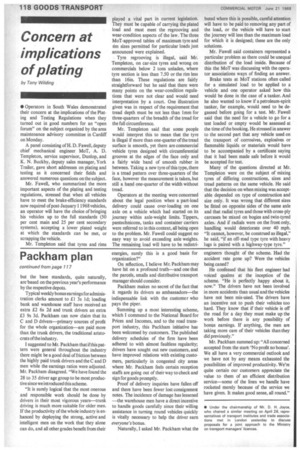Concern at implications of plating
Page 120

If you've noticed an error in this article please click here to report it so we can fix it.
by Tony Wilding
• Operators in South Wales demonstrated their concern at the implications of the Plating and Testing Regulations when they turned out in good numbers for an "open forum" on the subject organized by the area maintenance advisory committee in Cardiff on Monday.
A panel consisting of H. D. Fawell, deputy chief mechanical engineer MoT, A. D. Templeton, service supervisor, Dunlop, and K. N. Buckby, deputy sales manager, York Trailer, gave short addresses on plating and testing as it concerned their fields and answered numerous questions on the subject.
Mr. Fawell, who summarized the more important aspects of the plating and testing regulations, stressed that when all vehicles have to meet the brake-efficiency standards now required of post-January 11968 vehicles, an operator will have the choice of bringing his vehicles up to the full standards (50 per cent main and 25 per cent secondary systems), accepting a lower plated weight at which the standards can be met, or scrapping the vehicle.
Mr. Templeton said that tyres and rims
played a vital part in current legislation. They must be capable of carrying the plated load and must meet the regrooving and wear-condition aspects of the law. The three MoT-approved tables of maximum tyre and tim sizes permitted for particular loads just announced were explained.
Tyre regrooving is illegal, said Mr. Templeton, on car-size tyres and wrong on commercials below 2 tons unladen, where tyre section is less than 7.50 or the rim less than 16in. These regulations are fairly straightforward but he said that there were many points on the wear-condition regulations that were not clear and would need interpretation by a court. One illustration given was in respect of the requirement that tread depth must be not less than 1mm for three-quarters of the breadth of the tread for the full circumference.
Mr. Templeton said that some people would interpret this to mean that the tyre is illegal if more than one-quarter of the tread surface is smooth, yet there are commercial vehicle tyres designed with circumferential grooves at the edges of the face only and a fairly wide band of smooth rubber in between. Taking a new tyre of this type, there is a tread pattern over three-quarters of the face, however the measurement is taken, but still a band one-quarter of the width without tread.
Operators at the meeting were concerned about the legal position when a part-load delivery could cause over-loading on one axle on a vehicle which had started on its journey within axle-weight limits. Tippers, pantechnicons, tanks and container carriers were referred to in this context, all being open to the problem. Mr. Fawell could suggest no easy way to avoid exceeding axle weights. The remaining load will have to be redistri
buted where this is possible, careful attention will have to be paid to removing any part of the load, or the vehicle will have to start the journey will less than the maximum load for which it is designed; these are the only solutions.
Mr. Fawell said containers represented a particular problem as there could be unequal distribution of the load inside. Because of this the MoT was discussing with the operator associations ways of finding an answer.
Brake tests at MoT stations often called for a simulated load to be applied to a vehicle and one operator asked how this would be done in the case of a tanker. And he also wanted to know if a petroleum-spirit tanker, for example, would need to be degassed before going for a test. Mr. Fawell said that the need for a vehicle to go for a test loaded or empty would be assessed at the time of the booking. He stressed in answer to the second part that any vehicle used on the transport of corrosives, explosives or flammable liquids or materials would have to be accompanied by a certificate saying that it had been made safe before it would be accepted for test.
Many of the questions directed at Mr. Templeton were on the subject of mixing tyres of• differing constructions, sizes and tread patterns on the same vehicle. He said that the decision on when mixing was acceptable depended on type of construction and size only. It was wrong that different sizes be fitted on opposite sides of the same axle and that radial tyres and those with cross-ply carcases be mixed on bogies and twin-tyred axles.. And if radials were on the front only, handling would deteriorate over 40 mph. "It cannot, however, be construed as illegal," he said, "if an offroad type tyre with heavy lugs is paired with a highway-type tyre."








































































































































































































